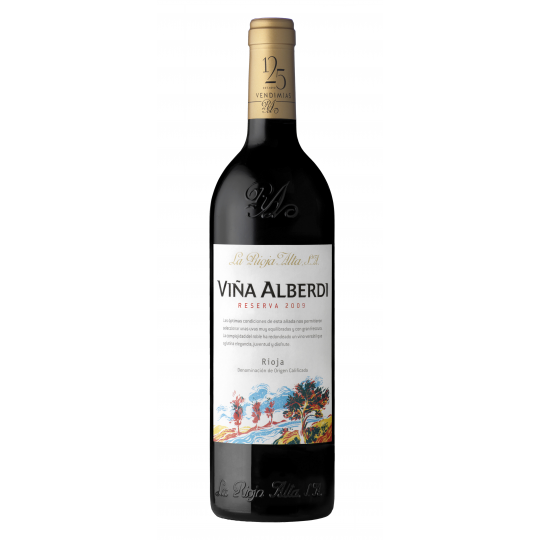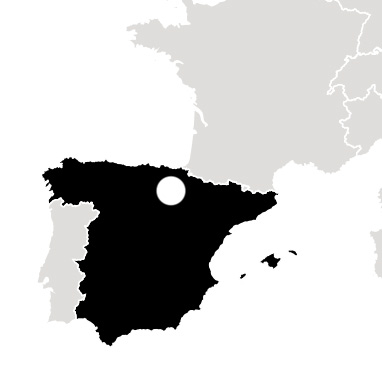Waarom deze wijn?
Deze Viña Alberdi 2009 is in WineSpectator bestempeld als 'a real Smart Buy!' Een heerlijke ouderwetse, toegankelijke Rioja met veel frisheid uit het hart van de Rioja. Deze wijn is elke euro meer dan waard en kan nu al van genoten worden.
De smaak
Helder en levendig, diep kersenrood. Intense geur van rijpe rode bessen en gebrande koffie, caramel en balsamico. Elegant en een mooie smaakopbouw, in balans en met zachte zoete tannines. Een frisse en lange afdronk van zoet gekruide noten, gekonfijt fruit, chocolade, gebrande koffie en caramel.
De details
type wijn: medium bodied
druivensoort: 100% Tempranillo
teelt: conventioneel
opvoeding: 2 jaar op Amerikaans eiken, 2 jaar op fles
alcoholgehalte: 13,50 % vol.
afsluiting: natuur kurk
drinktemperatuur: 17 graden
bewaarpotentieel: 2016 - 2020
spijs-aanbeveling: vlees gegrild en roodvlees, bbq brede varieteit aan gerechten snacks, voorgerechten, pasta, gerechten met rijst, stoofschotels en ook vis
De prijzen elders?
Wij vergelijken het voordeel altijd met de prijzen in de online-markt. Belangrijk is dat er dan wel 'appels met appels' worden vergeleken; dus precies dezelfde wijn van (bij voorkeur) hetzelfde jaar èn bij jou thuisbezorgd.
De oorsprong
Met Lopez de Heredia en Muga vormt La Rioja Alta het driemanschap van de 'Classic Rioja.'
In 2012 schreef Robert Parker:
'The winery La Rioja Alta formed part of my 'classic Rioja' day. I have admired their wines for many years, Rioja that speaks so eloquently and with such clarity of their place. La Rioja Alta was founded in the town of Haro in 1890. They own 450 hectares of vineyard from which their entire portfolio is sourced, predominantly Tempranillo complemented by Graciano, Mazuelo and Garnacha. Another tenet is their use of American rather than French oak. The wood is cured for two years outdoors before being shaped and hammered into barrels at their own cooperage.
I focused upon recent releases from their two Rioja lines: Torre de Ona and of course, La Rioja Alta itself. Quite simply, these are some of the finest Riojas that can grace your cellar: complex, refined, classic but without compromising fruit intensity and to reiterate: wines that speak about where they come from.'
Slimme weetjes: de drie Rioja wijnregio's
The three principal regions of La Rioja are Rioja Alavesa, Rioja Alta and Rioja Baja with each area producing its own unique expression of Rioja wine. Most of the territory subjected to the Rioja Protected designation of origin is in the La Rioja region, even though their limits do not coincide exactly. There is a narrow strip in the left bank of the Ebro river lying in the southernmost part of Álava included in the La Rioja wine region, whereas the south-southwestern part of the La Rioja region is not a part of this Protected designation of origin.
Rioja Alta and Ebro Located on the western edge of the region and at higher elevations than the other areas, the Rioja Alta is known more for its "old world" style of wine. A higher elevation equates to a shorter growing season, which in turn produces brighter fruit flavors and a wine that is lighter on the palate.
From Wikipedia, the free encyclopedia.
Slimme weetjes: de Rioja classificatie
Rioja red wines are classified into four categories. The first, simply labeled Rioja, is the youngest, spending less than a year in an oak aging barrel. A crianza is wine aged for at least two years, at least one of which was in oak. Rioja Reserva is aged for at least three years, of which at least one year is in oak. Finally, Rioja Gran Reserva wines have been aged at least two years in oak and three years in bottle. Reserva and Gran Reserva wines are not necessarily produced each year. Also produced are wines in a semi-crianza style, those that have had a couple of months oak influence but not enough to be called a full crianza. The designation of crianza, Reserva etc. might not always appear on the front label but may appear on a neck or back label in the form of a stamp designation known as Consejo.
The Spanish appellation hierarchy was most recently updated in 2009, and are as follows:
DOC (formerly DOCa) - Denomenacion de Origen Calificada, is the highest category in Spanish wine law, reserved for regions with above-average grape prices and particularly stringent quality controls. Rioja was the first Spanish region to be awarded DOC status in 1991, followed by Priorat in 2003. Priorat calls itself DOQ - Denominacio d'Origen Qualificada (Catalan) These are the only two regions considered "above" DO status.
DO - Denominacion de Origin, the mainstay of Spain's wine quality control system. Each region is goverend by a Consejo Regulardor, who decides on the boundaries of the region, permitted varietals, maximum yields, limits of alcoholic strength and other quality standards or production limitations pertaining to the zone.
DOP - Denominacion de Origen Provisional - status may be granted to aspiring regions.
VCIG - Vinos de Calidad con Indicacion Geografica, a level proposed in 2005 for wines better than vino de la terra but below DO. From mid to the bottom of the pyramid : VdIt = Vino de la Tierra to VdM = Vino de Mesa
From Wikipedia, the free encyclopedia.


